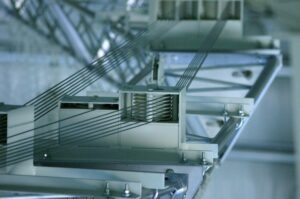Stagecraft combines technology and artistry to revolutionize theatrical performances and bring stories to life. One of the most important advancements in the industry is motorized stage rigging equipment.
Those systems offer a multitude of benefits ranging from enhanced safety to increased precision and are changing the landscape of theatre production. Learn about ten advantages of using motorized stage rigging.

#1: Enhanced Safety
Motorized stage rigging equipment provides a greater level of safety for your production. Manual
rigging relies heavily on strength and precision, but motorized systems reduce the risk of human error. That’s essential during complex scene changes and when handling heavy set pieces. Motorized rigging delivers smoother controlled motion, reducing the chance of curtain and set movements that could endanger people on stage.
The integration of advanced safety features in motorized systems further elevates security. These systems often include fail-safes, overload sensors and emergency stop functions to protect your performers and crew.
#2: Efficiency
Timing is critical in the fast-paced world of stage productions. Motorized stage rigging speeds up scene changes and set adjustments. Stagehands can execute complex set changes in seconds with preset movements and transitions. That capability helps maintain the flow of a performance and can be used to make an impact on audiences.
Motorized rigging systems can also save time during rehearsals. Your directors and stage managers can experiment with different scenic arrangements efficiently so they can focus more
on the creative aspects of production instead of organizing manual labor.
#3: Increased Precision
Motorized rigging equipment offers enhanced accuracy to create effective visual displays. Every movement can be executed with precision in computer-controlled systems, ensuring set pieces are in the right place at the right time.
These systems are ideal for repeatable movements, too. A sequence can be completed multiple times once it’s been programmed into a production. That allows you to maintain a consistent standard of precision during performances.
#4: Reduced Labor Costs
Implementing motorized stage rigging can help you save money on labor costs. Traditional manual rigging requires a crew of experienced riggers, especially for larger productions with complex staging requirements. Motorized systems are operated by fewer people since much of the heavy lifting and maneuvering is automated.
The reduction in the workforce directly impacts labor cost savings. It also reduces the need for training and rehearsal time for stagehands, further cutting down production expenses.
#5: Versatility
Motorized systems accommodate a variety of stage elements, from delicate props to massive set pieces. That presents you with more options for set designs that might not be possible with manual rigging.
You can adapt motorized rigging to fit different stage configurations. Whether you have a touring show to adjust for different venues or a resident production that requires new staging, motorized systems meet those diverse demands.
#6: Dynamic Set Changes
Efficient set changes are another advantage of motorized rigging. Scene and performance transitions become more fluid as motorized systems move set pieces, backdrops and lighting fixtures swiftly. That helps reduce downtime between scenes and keeps your audience engaged.
The use of motorized rigging also allows for more creative staging. Sets can evolve in front of your audience’s eyes, adding an element of spectacle to the production. You can enhance storytelling by making transitions a part of the narrative rather than a functional necessity.
#7: Consistent Performances
Consistency is crucial in theatre and live performances. Motorized stage rigging ensures each performance is as precise and impactful as the first. Eliminating the variables of manual rigging with a motorized system allows for consistent transition replication.
That enhances the audience’s experience and provides a safer environment for performers. Knowing that each element of the set will be in the same place every night allows those on stage to focus on their performance without worrying about stage conditions.
#8: Remote Control Capabilities
Some motorized rigging systems have remote control capabilities, allowing you to operate them from different locations within your venue. That flexibility is essential for productions where timing and light and sound synchronization are critical. Remote operation lets you make immediate adjustments during a performance, so you can make minor tweaks without disrupting the flow of your show.
#9: Technology Integrations
Motorized stage rigging systems are designed to integrate seamlessly with other stage technologies, such as lighting and sound systems. Those integrations present opportunities for creative collaborations between different departments. Your lighting designers can sync their cues with scenic movements and your sound designers can time effects to match set changes to create an immersive experience.
#10: Reduced Physical Strain
Motorized rigging reduces physical strain on your stage crew. Manual rigging is physically demanding and can be a source of injuries, especially over long runs or during preparation for large productions. Motorized systems take on the heavy lifting to your crew doesn’t have to work so hard.
That benefits the health and well-being of your crew and can improve morale and efficiency. A crew that’s not exhausted can work more effectively and contribute to the success of your. production.
Discover the transformative power of Tiffin Scenic Studio’s motorized stage rigging equipment, designed to elevate your theatrical productions with enhanced safety, precision, and efficiency. Embrace the future of stagecraft and unlock new creative possibilities for your performances. Visit us online to explore our innovative solutions and see how we can contribute to the success and dynamism of your next production!